The AMD Kabini Review: A4-5000 APU Tested
by Jarred Walton on May 23, 2013 12:00 AM ESTKabini Windows 8 Laptop Performance
With the SoC and “lighter device” benchmarks out of the way, let’s also look at what Kabini offers for a full laptop experience. Let me preface this section by simply stating many of our laptop benchmarks really aren’t a good fit for an APU like Kabini—e.g. doing 3D rendering or x264 HD encoding on such a chip is just asking for poor performance. We’re also looking at different OS configurations (Windows 7 vs. Windows 8, IE8/9 vs. IE10), so there’s a slightly higher potential for margin of error here.
Our current list of laptops includes AMD's Brazos E-350 (MSI X370), Kabini A4-5000, and Trinity A10-4600M; on the Intel front we have i7-3517U (Dell XPS 12) and Pentium 2020M (a late addition when we managed to get a laptop for short-term testing). Both of the Intel chips are 22nm parts, but note that the Pentium chip is a 35W part. Sadly, we have not yet been able to get a Pentium 2117U as a comparison. [Note: Some laptops are still being tested on some of the benchmarks; their scores will be added/updated as they complete.]
We do want to see what sort of gains are present relative to Brazos, however, so let’s get started. We’re presenting an abbreviated look at performance here, but we have the full set of benchmark results in Mobile Bench, including some of our older benchmarks that we’ve run against Brazos and other laptops prior to 2013. There are two main questions to consider for each benchmark: how much faster is Kabini than Brazos (and where does it place relative to other options), and does Kabini provide enough performance to handle the task represented by the benchmark?
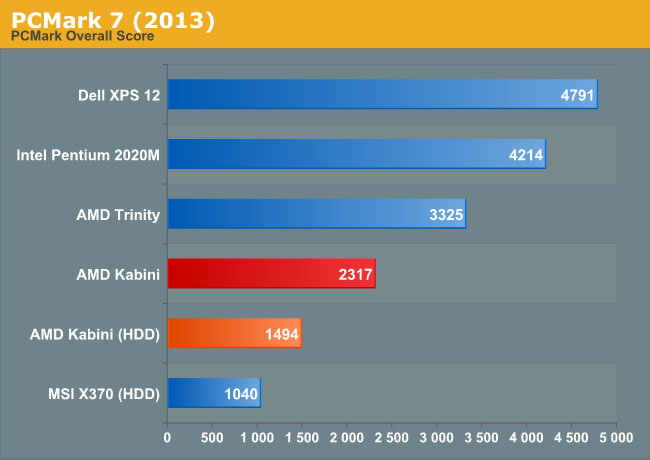
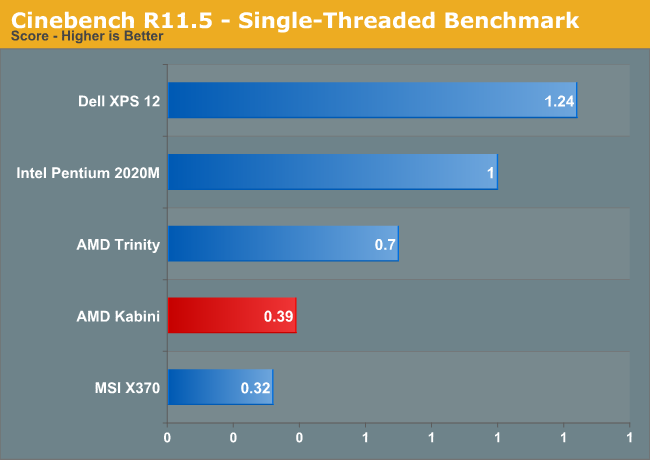
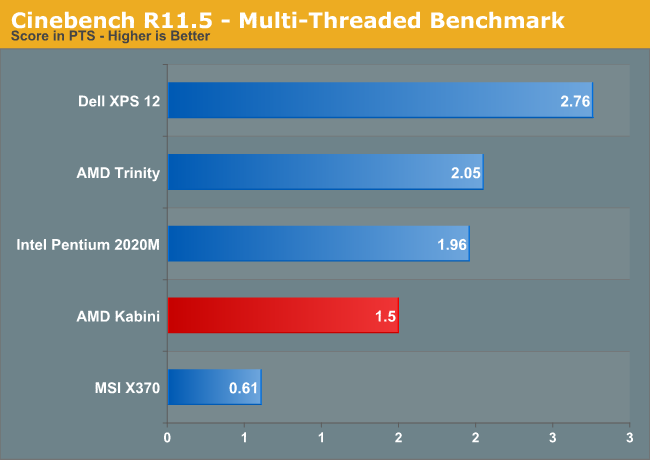
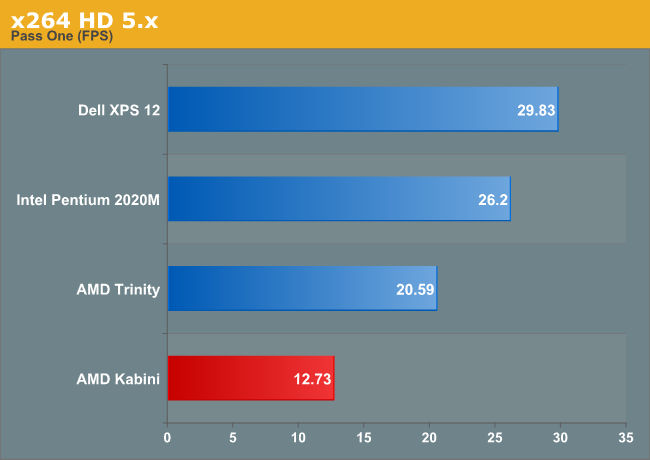
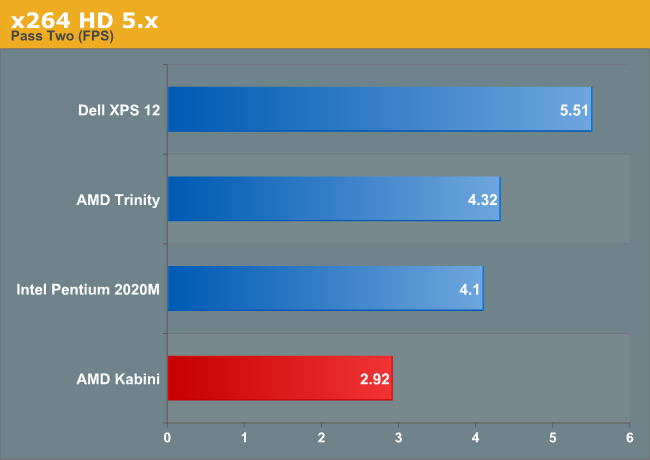
Starting with PCMark 7, we have both HDD and SSD results. As usual, the presence of an SSD boosts performance in the overall score by more than 50%, so Kabini with an SSD can feel far more responsive than Ivy Bridge with an HDD, depending on the task. Relative to Brazos, even with an HDD on both laptops, Kabini is nearly 50% faster. ULV Ivy Bridge on the other hand offers twice the performance of Kabini in the overall score, though Quick Sync skews that pretty heavily. Looking at the individual results, ULV IVB is around 30-50% faster on most CPU tasks, and it’s even a bit faster on the GPU side in most areas as we’ll see in a moment.
Update: We've added Pentium 2020M to the above charts, which lacks Quick Sync support and runs at a maximum clock speed of 1.8GHz. It's clearly slower than the i7-3517U in the Dell XPS 12, but it's also still a healthy step up from Kabini in terms of performance. The 2020M is a full 35W part, like the A10-4600M, and it tends to slightly outperform Trinity on CPU tasks while trailing in GPU performance. On the Kabini front, however, even the Pentium 2020M is able to lead on nearly all the performance metrics.
The CPU performance testing of x264 HD 5.x and Cinebench confirm the CPU deficit AMD faces with Kabini. In heavily threaded workloads, Ivy Bridge ULV is 50-100% faster, but the real problem is in the single-threaded workloads. A single Jaguar core in Cinebench manages to score just 0.39 compared to IVB ULV’s score of 1.24, so worst-case Kabini is one third the speed of Ivy Bridge. Standard Voltage Trinity APUs are likewise a big step up from Kabini, offering roughly twice the CPU performance in some cases. Of course, the power draw from standard Trinity tends to be far higher than Kabini.

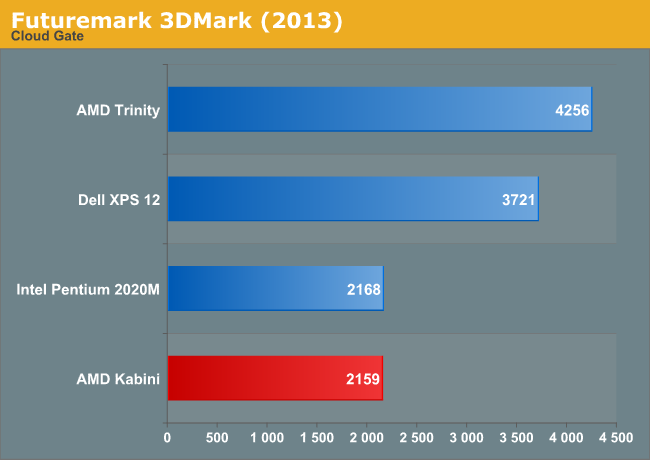
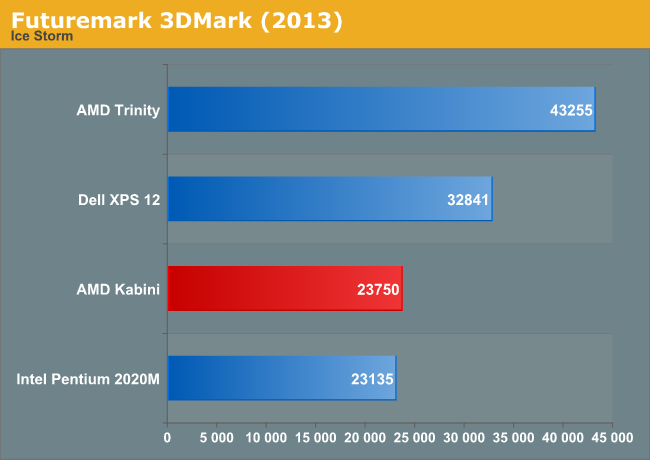
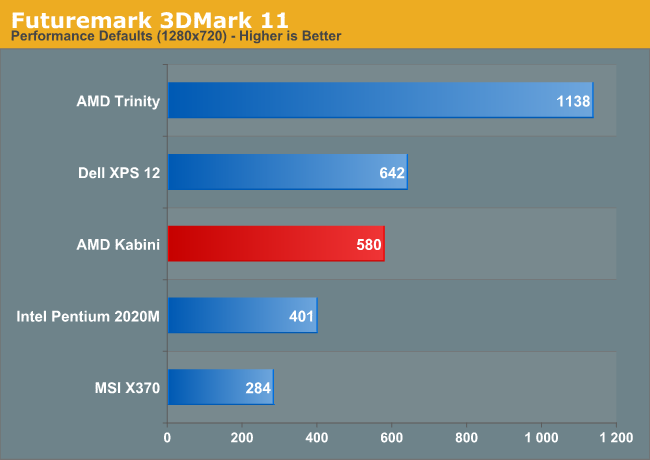
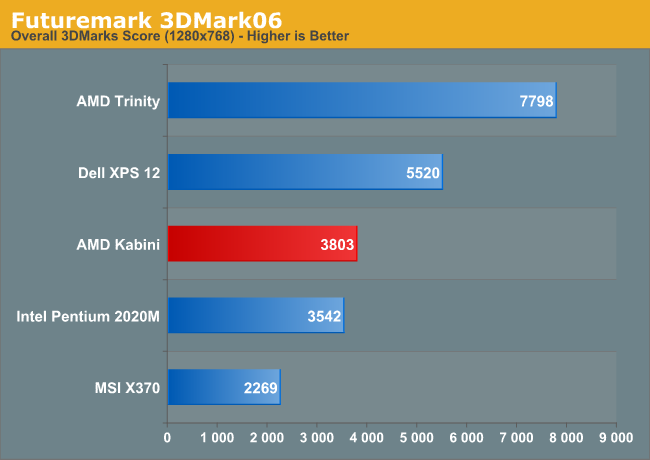
Quickly looking at the 3DMark results, if you were hoping Kabini would be fast enough to handle modern games at moderate detail settings, the relative standings in 3DMark should help prep you for what’s to come. The A10 Trinity can handle many titles at moderate details, but even it struggles with many of the latest releases; Kabini has about a third of the total GPU compute performance of Trinity, and while it’s a bit faster than that in some games, for the most part it’s best suited for older games that don’t require as much from the CPU or GPU.
As for Intel's chips, while the Core i7 ULV part ends up faster than Kabini, the same can't be said of the Pentium 2020M; it's a tie in some tests but falls behind (sometimes significantly, e.g. 3DMark 11) in others. As neither chip is really fit for high-end graphics work, it's not really a major concern. If you want decent graphics performance, you're going to want more than either Kabini or Ivy Bridge has to offer.










130 Comments
View All Comments
whyso - Thursday, May 23, 2013 - link
kabini only has a single channel memory controller. Going to two DIMMS would not improve performance at all.Gaugamela - Thursday, May 23, 2013 - link
He didn't mention dual channel memory not even once in his comment. He mentioned comparing a inexpensive chip that competes against Atoms/Pentiums in price/performance/TDP with an intel i5 which is a much more powerful chip.Roland00Address - Thursday, May 23, 2013 - link
I wonder how starvered the cores are for memory bandwith. Even the xbox one will be using quad channel memory (4 64 bit controllers) and 2133 mhz instead of 1600, that is over five times the bandwidth. The ps4 keeps the quad channel but uses gddr5 memorywhyso - Thursday, May 23, 2013 - link
Well the xbox one has 6x the igp and the ps4 has 9x the igp.Roland00Address - Thursday, May 23, 2013 - link
I am not asking if the gpu is bandwidth starved but is the cpu bandwidth starvedI understand why amd went single channel, I am just curious if dual channel would make a difference
whyso - Thursday, May 23, 2013 - link
CPU is almost never bandwidth starved. Literally, you can run a 3770k on 1033 mhz ram and outside winrar you will never notice any differences compared to 2133 mhz ram. 3770k is dual channel but more than 4x as powerful as this kabini apu.Roland00Address - Thursday, May 23, 2013 - link
Your statement that an i7 does not need faster memory does not necessarily translate to this situation with jaguar and that is why I am curious if the cores are starved. I wish it was possible for anandtech to test this (but it is very hard to do so for there isn't really laptop ram faster than 1600 mhz for laptops). Here is why you can't just assume what works with an i7 translates with the jaguar chip.533 mhz dual channel is equivalent to 1066 single channel. (Remember i7-3770k is dual channel while amd jaguar in this implementation is single channel). Thus you can't just assume an i7 is fine with dual channel, than the jaguar would be fine with single channel for the i7 has 100% more bandwidth due to it being dual channel.
Furthermore i7-3770k is intels high performance architecture with large r&d vs amd's energy efficent architecture with small r&d chip. It is very likely intel has better data predictors in their i7 so there's less cache miss and thus you don't care about the memory speed. Intel R&D money is a big deal and translates into better IPC for many reasons including branch prediction.
Lets put it this way arm is going higher bandwidth for more ipc. Tegra 3 is a mere single channel 32 bit controller, Tegra 4 is likely to be a dual channel 32 bit controller, Exynos 5 uses a dual channel 32 bit controller. Apple on their Ipads now use a quad channel 32 bit controller. One reason why exynos and ipad were faster than tegra 3 was better memory bandwidth.
I am not saying you will see improvements greater than 20% but I am curious if faster memory speeds would cause ipc to go up from 5 to 20%. For example with bulldozer amd gets 8% faster encoding with x264 first pass with 2133 memory dual channel instead of 1333 dual channel according to vr-zone.
It may not be in amd best interest to make the jaguar chip dual channel 64 bit for cheap laptops that compete against intel's celeron or pentium lines, for laptops. Yet at the same time Jaguar is going to be AMD process for low power in the future. It is quite possible that AMD may in the future (if the tdp is low enough) make a 20nm dual channel chip for the higher margin tablets, high margin tablets would insist on higher ipc for the cpu and more bandwidith for the screen, while low margin cheap computers would not care about increase ipc. It is possible that in the future AMD can find a sweet spot between intel atom and intel haswell. (I am not saying this is likely, just merely possible all depends on intel's pricing to oems for haswell.)
whyso - Thursday, May 23, 2013 - link
It is extremely unlikely for this chip's cpu to be hurt by memory bandwidth. Sure the i7 has 100% more bandwidth but you must factor in the power of the chip. The i7-3770k is going to be something like 6x more powerful (3.7 ghz turbo + IPC advantage + HT). Even if the kabini chip tested in this review was half as efficient as the 3770k in utilizing memory bandwidth it still wouldn't show any differences in cpu performance.Phone/tablet SOCs mainly need the bandwidth for the gpu portion of the die (the high res screen was the reason that apple needed such an interface). If they need more bandwidth it'll be for the igp portion of the die (definitely 1066 mhz ram on a single channel will hurt this thing) for kabini.
geoflouw - Thursday, May 23, 2013 - link
Need a comparison against Haswell and Baytrail please. This data is misleading, i really would hope AMD can compete with 1 year old CPUs and SOCs.....smilingcrow - Thursday, May 23, 2013 - link
It’s hardly misleading. Haswell is still under NDA and Bay Trail is due around Q4 which is why they aren’t compared. The better comparison will be Bail Trail based on pricing and performance. AMD should still have a healthy lead for GPU but if Intel’s recent info is true it should be close on the CPU front. The main difference is that Bay Trail has a low enough TDP for a cheap fanless tablet whereas the chip reviewed today is 15W so Ultrabook class. So you get two out of four with AMD:The Good: GPU + Price
The Bad: power consumption + low IPC
So business as usual really.